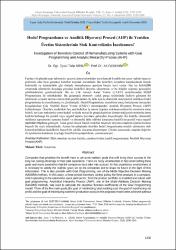Hedef programlama ve analitik hiyerarşi prosesi (ahp) ile yeniden üretim sistemlerinin stok kontrolünün incelenmesi
Künye
Arsu, T , Özdemir, A . (2019). Hedef Programlama ve Analitik Hiyerarşi Prosesi (AHP) ile Yeniden Üretim Sistemlerinin Stok Kontrolünün İncelenmesi . Afyon Kocatepe Üniversitesi Sosyal Bilimler Dergisi , 21 (4) , 1230-1245 . DOI: 10.32709/akusosbil.518293Özet
Faydayı ön planda tutan işletmeler, geçmiş deneyimlerinden yararlanarak kendilerine uzun vadede başarıyı
getirecek olan bazı gerçekçi hedefler koymak zorundadır. Bu hedefleri koyarken karşılaşılacak birçok
belirsizlik ve işletmelerin göz önünde bulundurması gereken birçok kısıt vardır. İşte bu belirsizlik
ortamında işletmenin koyduğu gerçekçi hedefleri doyuma ulaştırması ve bu bilgiler ışığında geleceğini
şekillendirmesi gerekmektedir. Bu da Çok Amaçlı Karar Verme (ÇAKV) metotlarından Hedef
Programlama ile mümkündür. Bu çalışmada otomotiv yedek parça sektöründe faaliyet gösteren bir
işletmenin yeniden üretim sistemi ürün portföyünden, üç ürün için üç dönemlik stok kontrol politikası hedef
programlama ile modellenmiş ve çözülmüştür. Hedef Programlama modelinin amaç fonksiyonu katsayıları
hesaplanırken Çok Nitelikli Karar Verme (ÇNKV) metotlarından Analitik Hiyerarşi Prosesi (AHP)
kullanılmıştır. Önerilen modeldeki beş ana hedeften üç tanesi (toplam stoklama maliyetini minimize etme
hedefi, net karı maksimize etme hedefi ve fazla mesai ile gerçekleştirilen üretim maliyetini minimize etme
hedefi) herhangi bir pozitif veya negatif sapma meydana gelmeden başarılmıştır. İki hedefte (dönemlik
stoklama kapasitesini aşmama hedefi ve dönemlik ürün talebini karşılama hedefi) ise pozitif veya negatif
sapmalar meydana gelmiştir. Fakat genel olarak birçok hedefini başarıyla doyuma ulaştıran işletme kısmen
başarılı bir seyir izlemektedir. Ayrıca bu çalışmada önerilen hedef programlama modeli işletmenin stok
kontrol politikası hedeflerini başarılı br şekilde doyuma ulaştırmıştır. Çözüm sonucunda ulaşılan değerler
ile işletmenin kendisine koyduğu hedefler karşılaştırılarak yorumlanmıştır. Companies that prioritize the benefit have to set some realistic goals that will bring them success in the
long run, taking advantage of their past experience. There are many uncertainties to face when setting these
goals and many constraints that the companies must take into account. In this uncertainty environment, it
is necessary to satisfy the realistic goals set by the companies and to shape its future in the light of this
information. This is also possible with Goal Programming, one of the Multi-Objective Decision Making
(MODM) methods. In this study, a three-period inventory control policy for three products in a company,
which operating in the automotive spare parts sector, from the product portfolio is modeled and solved with
goal programming. Analytical Hierarchy Process (AHP), one of the Multi-Attribute Decision Making
(MADM) methods, was used to calculate the objective function coefficients of the Goal Programming
model. Three of the five main goals (the goal of minimizing total stocking cost, the goal of maximizing net
profit and the goal of minimizing overtime production costs) in the proposed model were achieved without any positive or negative deviation. The other two main goals (the goal of not exceeding the periodical
storage capacity and the goal of meet the demand for periodical products) have positive or negative
deviations. However, in general, the company, which successfully satisfies many of its objectives, is
partially successful. In addition, the goal programming model proposed in this study successfully satisfy
the inventory control policy objectives of the enterprise. The values obtained as a result of the solution are
compared with the goals set by the company.
Kaynak
Afyon Kocatepe Üniversitesi Sosyal Bilimler DergisiCilt
21Sayı
4Bağlantı
https://dergipark.org.tr/tr/pub/akusosbil/issue/51207/518293https://hdl.handle.net/11630/9119
Koleksiyonlar
- Cilt 21 : Sayı 4 [22]



















